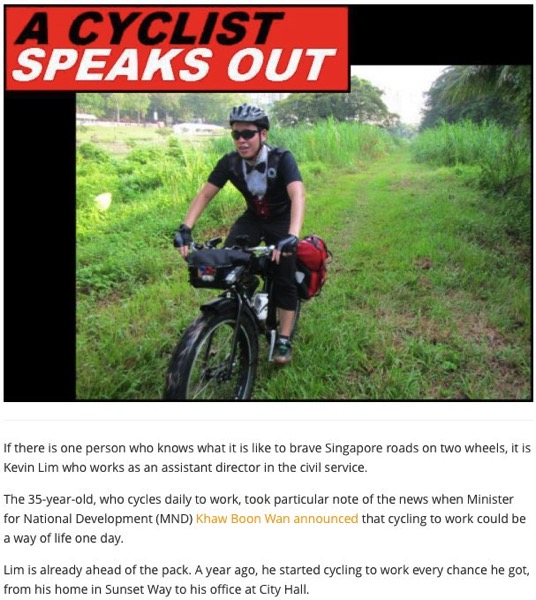Kevin Lim explains in an inSing article, "
Cycling as a way of life? It’s possible"
"Cycling as a way of life? It’s possible," by Gregory Leow and Irene Lee. inSing, 05 Feb 2013. Updated 07 April 2014.
If there is one person who knows what it is like to brave Singapore roads on two wheels, it is Kevin Lim who works as an assistant director in the civil service.
The 35-year-old, who cycles daily to work, took particular note of the news when Minister for National Development (MND) Khaw Boon Wan announced that cycling to work could be a way of life one day.
Lim is already ahead of the pack. A year ago, he started cycling to work every chance he got, from his home in Sunset Way to his office at City Hall.
He sets off 8am in the morning, rides along Ulu Pandan canal to Commonwealth Avenue, gets onto the Alexandra Park Connector, passes through Zion Road, Robertson Quay and Clarke Quay, and finally wheels up to his office at Victoria Street.
He estimates that he travels 12km in just under an hour and at the end of the work day, he hops onto his bicycle and cycles back.When Lim first heard about the bicycle accident in Tampines that claimed the lives of two boys, he was saddened by the news because he says it only takes a bit of awareness and small changes to the traffic design to make roads safer for cyclists.
Simply giving pedestrians and cyclists more rights on the roads like designated bicycle lanes or bolder pedestrian crossing lines would help tremendously.
But he worries about the KPI (key performance indicators) driven work culture that pressures workers to be more productive. Like the cement truck driver involved in the Tampines accident, such work culture can lead to more reckless driving on roads.
“The most important point is that no matter whose right of way it is, one should stay clear or slow down when there are children nearby. Back in the ’90s, there used to be dark blue road signs to indicate children at play, but I rarely see them now,” says Lim, who cycles to get “a sense of freedom” and for fitness.
The tragic accident motivated him to head down to Tampines to examine what the traffic conditions are like. While he saw wider pedestrian paths for cyclists – as Tampines new town is designed to be bicycle-friendly – he also saw high vehicle traffic in the area.
“You have no choice but to cross these streets located at critical traffic junctions,” he observes.
Lim welcomes Minister Khaw’s announcement that more park connectors (PCN) and bicycle lanes will be built in the future to facilitate cycling to work.
“Currently, PCNs will never get you all the way to your destination, which would be nice since cycling on them is less stressful than riding on the roads with traffic,” he adds.
That would also counter the other problem he highlights, that Singapore has a high proportion of recreational cyclists who are not as cautious as veteran cyclists who ride on the roads regularly.
“When they transition from PCNs to roads, they might not be aware or be overwhelmed by all the dangers around them. It takes time to get used to it,” says Lim.
You have to be extra careful cycling on the roads as Lim has experienced dangers such as sleepy drivers and a lack of cycling road infrastructure.
“More than one time, a bus or truck driver has cut in front of me while I’m cycling on the left side of the road, but they underestimate how fast cyclists actually are. I get forced against the kerb or I am made to slam on our brakes to avoid getting killed,” warns Lim, recounting a personal incident.
“Cyclists should try to be as visible as possible, but always keep a lookout for bad drivers. Once you’re in a crash, cyclists rarely make it out alive to tell their side of the story.”

No comments:
Post a Comment